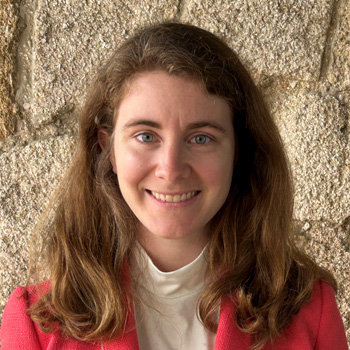
Please welcome Dr. Claire Gabe to the Whitney Lab! She joins the lab as a Postdoctoral Research Associate.
With an initial interest in biomedical sciences, Claire pursued her undergraduate studies in Biochemistry at the University of Lyon, France. During an Erasmus exchange in Manchester (UK) in her final year, where she gained her first hands-on research experience. She particularly enjoyed the creativity, problem-solving, critical thinking, and collaborative nature of research—and also caught the 'travel bug’!
After graduating in 2012, she completed an MSc in Pharmaceutical sciences, where she developed a keen interest in misfolded protein diseases. This led her to pursue a PhD at the University of Leeds (UK), focusing on the mechanisms underlying amelogenesis imperfecta—an inherited dental enamel condition. This also marked her first step into the field of biomineralization. During her PhD, she developed a method to purify recombinant amelogenin, the major enamel matrix protein, for in vitro function studies. She optimized various protein purification techniques and designed a fluorescence-based tool to study protein aggregation behavior. After graduating in 2019, she briefly continued this work as a postdoctoral researcher before moving on to her next step.
In 2021, she joined the University of Pittsburgh as a postdoctoral researcher, transitioning into in vivo systems. Using a mutant mouse model, she investigated the role of amelogenin phosphorylation in enamel formation- more specifically, regulating the mineralization rate, pH, and protein conformation in the enamel extracellular matrix. She became familiar with spectroscopy techniques. Through conferences and collaborations, she developed a growing interest with the broader field of biomineralization—beyond teeth—spanning disciplines like marine biology.
Now at Whitney, she is excited to apply the skills she learned from mouse teeth to the marine world. She has joined Dr. Martindale’s lab, where she will be working on expressing and purifying biomineralization proteins using sea starlet Nematostella Vectensis as a protein expression platform. Her research will also focus on understanding the structure and function of these intrinsically disordered biomineralization proteins and the role of their post-translational modifications.
Outside the lab, she enjoys artistic and outdoor activities. Art-wise, she likes drawing and painting - in particular, abstractions and portraits. Outdoors, she will keenly go for a run or swim by the sea. She also likes kayaking, hiking, and skiing. Indoors she enjoys cooking, sharing nice meals, and board games.